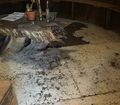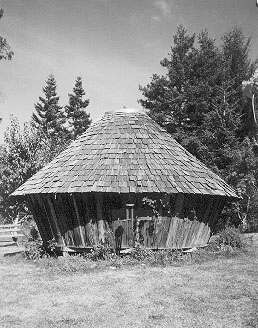
The yurt at CCAT, as pictured above, differs in design from both traditional and imported styles of yurts. The most notable differences are that the walls are made out of plywood board and the roof is covered in wood shingles. Also, on the inside, there is a bench built into the wall that circumscribes the entire floor.
This yurt was built to be a permanent structure and is used on campus for a gathering place. Please see CCAT's webpage and take the virtual tour for more pictures of the yurt.
Over the years many improvements have been made to the yurt including the addition of a solar PV system to power LED lights and small AC loads and a new roof made from recycled cans that is fully equipped with Liter-of-Light bottles to provide day lighting. See the operation and maintenance instructions on how to best care for this technology at the Appropedia page CCAT yurt/OM.
Rainwater catchment
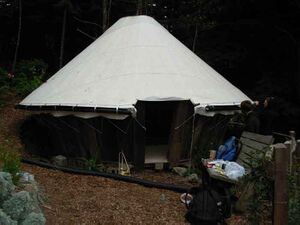
Our project for ENGR 114 was to build a rainwater catchment system around the yurt at CCAT on campus at Cal Poly Humboldt. The purpose of the rainwater catchment system is to capture and store rainwater in a large storage drum for use to water plants on the CCAT grounds. Water is a resource that is always present around us but not always in an immediately useful form. Therefore, it is necessary that we use innovative and appropriate techniques to capture and transform the water that we have into a useful form of water for our needs.
The long history of rainwater collection, can be traced (in recorded history) as far back as ancient times some 3,000 years ago (850 BC) if not even farther. The need for water is a basic human essential for maintaining life, without it, no civilization could have prospered. Rainwater collection in ancient Constantinople is one of the last megalithic structures of its kind. The CCAT Rainwater Catchment Group consists of: Sean Colley, Matt de Young, Jessica Radtkey, Sarah Shimizu, and Tiesha Whittaker. Taken from: http://web.archive.org/web/20190126224328/http://www.rain-barrel.net:80/rainwater-collection.html
Our Rainwater Catchment System is located around the Yurt at The Campus Center for Appropriate Technology (CCAT) on the HSU Campus
Retaining wall
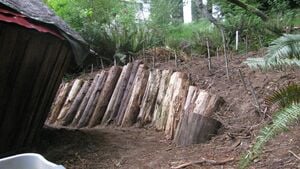
Hello, and welcome to our Spring 2013 Appropriate Technology project at Cal Poly Humboldt (HSU). Our team is comprised of Ivan Diankov and Alex Kato. We will be designing and constructing an erosion control system on the slope behind the CCAT yurt house at HSU's Campus Center for Appropriate Technology (CCAT). Erosion control and slope management come in many forms. From retaining walls to bio-engineered erosion control (BEC) techniques, there are various methods to maintain and control a hillside. The use of BEC techniques specifically provides avenues to enrich the surrounding area with more plant life and thus more stability than a traditional retaining wall.
Update 2013
See the new roof made from tin cans at SALIRAJA Yurt Project.

Update 2014
See the operation and maintenance instructions on how to best care for this technology at the Appropedia page CCAT yurt/OM developed by HSU's Spring 2014 Engineering 535 team Drew Clark, Amit Khare, and Billy Karis.

Roof 2019
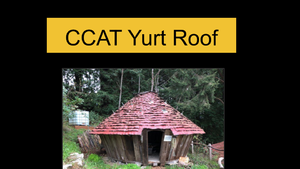
The CCAT Yurt was designed as a place where students and community members could come in and achieve a sense of relaxation.
It fits in quite well at CCAT for its educational space for appropriate technology. The roof of the yurt has undergone some renovation in order to reduce it's impact on the environment, and add some aesthetic significance to it. Time has taken its toll on the yurt, and there is visible wear and tear to the roof. The roof has begun to leak and this could lead to damage inside. We were tasked by CCAT to find a solution to correct the issues with the leaky roof, and so the yurt may continue to serve as an educational example of alternative building. Our hope is that we may renovate or replace the yurt roof, and maintain it's appeal for gathering with friends and colleagues.
Results from our project: We wished to minimize the amount of leaks which exist along the yurt roof, and we worked with CCAT to test different solutions to reduce water leaks. Our efforts and observations resulted in three projects which modified or addressed renovating the yurt roof. The projects include: Repairing the coke bottle light portals. Creating a demonstration board with potential roof materials. Sealing the skylight gaps to reduce the leaking.
Update September 2019
As of Fall 2019, the Yurt House at CCAT is still up and available for students to go in and use it as a sense of relaxation.
The Yurt Roof however, needs a lot of maintenance as soon as possible. The new bottle cans that were just installed, Spring 2019, are starting to fall out. The tape that was used to seal the bottles in but allow them to take the bottles out and clean it when needed is not withstanding the wear and tare or the rain.
The skylight was sealed with a liquid sealant glue that does not look good on the inside nor is it good for the carbon footprint and sustainability. With the leaking, no mold has formed from what is has been seen but the floor is a little unstable so a new floor that is stronger is needed.
Even with the house serving its purpose for its students, a lot of renovation needs to be done to stop the leaks and keep the carbon footprint down.
-
Bottle holes where the bottle has fallen out
-
Demo of what possible material to use on roof
-
Yurt FLoor
-
Up close view of the Yurt Roof
Resources
Tipis and Yurts, by Blue Morning Star
Web resources:
- CCAT's webpage - www.humboldt.edu/~ccat
Society for Creative Anachronism pages
Commercial Yurt builders' Websites
- www.yurtpeople.com The Yurt People
- www.yurtworks.com Oregon Yurtworks


